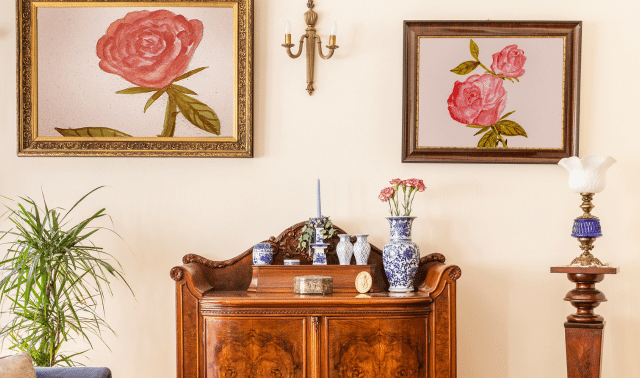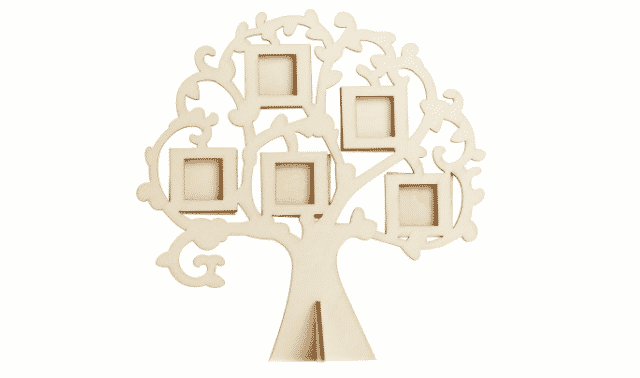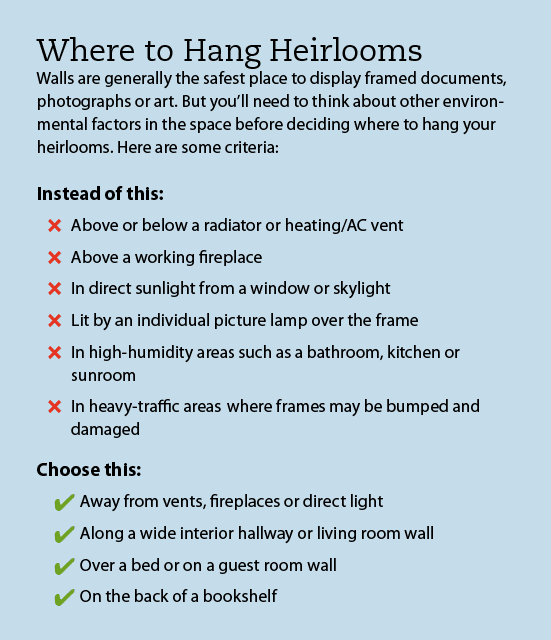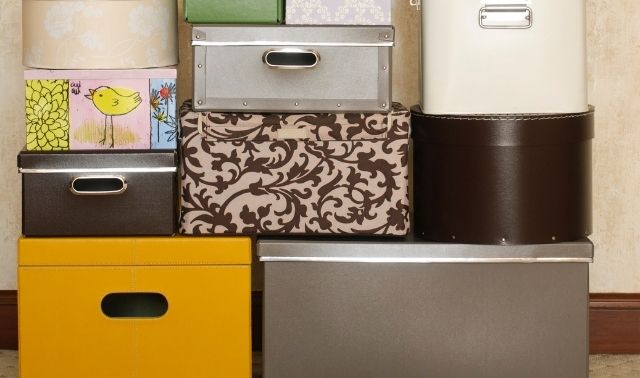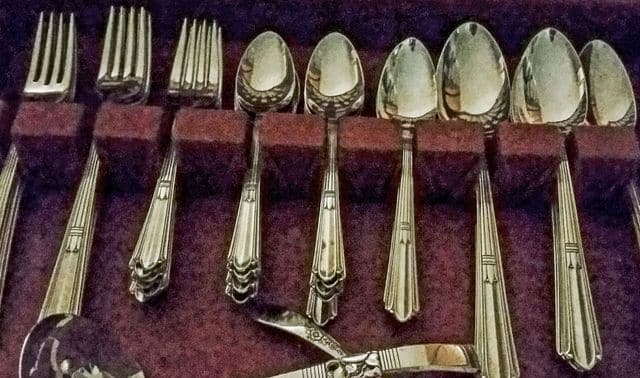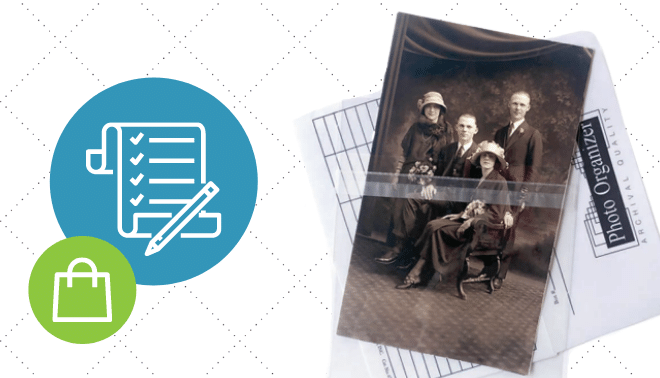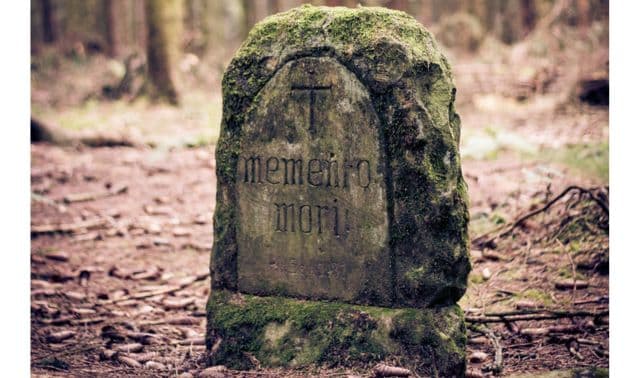Sign up for the Family Tree Newsletter! Plus, you’ll receive our 10 Essential Genealogy Research Forms PDF as a special thank you.
Get Your Free Genealogy Forms
"*" indicates required fields
Text by Denise May Levenick unless otherwise noted.
You don’t have to be a genealogist to love heirlooms. But if you’re the keeper of your family’s stories and history, you probably also oversee your family’s photos, documents and memorabilia.
As the family archivist, you may have conscientiously organized and preserved materials in acid-free archival storage files and boxes. You may have even scanned many items and carefully backed up your digital files.
ADVERTISEMENT
But you’re not finished yet. Keepsakes are the material objects that hold the memories of family stories. And family stories are meant to be shared.
A vintage bottle of cologne is a memory of Grandma dressed for church with her hat and gloves. An old baseball glove might be scuffed and cracked, but it still holds memories of playing catch with your dad and brother before dinner.
Your home may not be a museum. But it’s possible to safely display and enjoy family heirlooms as part of your daily life. In this article, we’ll discuss how to display your heirlooms—and what to consider when deciding if it’s safe to display certain items at all.
ADVERTISEMENT
Deciding Whether to Display Heirlooms
The value of some collectibles such as Pokémon cards will go up and down. But others of historical interest will hold their value far into the future. Artifacts from the Civil War, NASA space program, or suffragette movement might be of interest to a museum or public archive, so you could consider donating them.
For most of us, however, our ancestors and the things they owned are valued more by our families than the general public. These family heirlooms are good candidates for safely sharing in our homes.
Your home may not be a museum. But it’s possible to safely display and enjoy family heirlooms as part of your daily life.
Ask yourself three questions to help decide whether or not to an artifact is better kept in preservation storage or carefully displayed at home.
- Who is associated with this object? Was it created or owned by one of your ancestors? Was the creator or owner a notable person?
- What is important about this object? Is the item over 100 years old, and does it hold unique artistic or cultural value? Did it play a part in a significant event, social movement, war or conflict, business or invention? Does it trigger memories of a specific person, place or event?
- How can this object be safely displayed? Is it especially fragile? Do you have the space and funds to safely store it in your home?
Nothing lasts forever. Our challenge as family historians is to balance preserving artifacts with sharing and learning from them. Weigh the benefits of placing an engraved silver cup on a bookcase where your family will see and ask about it against the risk it of getting damaged. Does the cup hold a story to share? Your answers can help you decide how and where to share your family heirlooms.
4 Major Threats to Your Heirlooms
Regardless of your answers to these questions, avoid the following rogues’ gallery of enemies to heirlooms:
Light
Sunlight, interior lamps, and fluorescent, halogen and incandescent lighting all produce damaging ultraviolet (UV) rays, which can harm materials. LED lighting is a much better choice for interior lighting near artifacts, and you should always display heirlooms away from direct sunlight and lamps.
Temperature and humidity
Frequent fluctuations in humidity are often caused by changes in temperature. Hot weather dries out the air—and papers, textiles, or other exposed objects. Cold weather is often accompanied by moisture, which can lead to mold and mildew. Paper subjected to repeated cycles of heat or cold typically becomes dry and brittle. Store documents, photos, textiles and most artifacts in an environment where temperature and humidity are stable and moderate. Aim for 65° to 70°F and 45 to 50% humidity, which is typical for most home interiors.
Pests
Common household bugs and moths love to find paper and natural fibers in dark, damp places. Dust and vacuum regularly under and behind items on display to avoid infestations.
Pollution
Smoke from cigarette- or cigar-smoking and soot from wood-burning fireplaces can leave objects with a residual odor. Incense, essential oils, and perfume can also leave lingering scents. Quilts, linens, clothing, paper and even wood will absorb fragrances or smoke odors. Avoid displaying any heirloom in a room that is heavily scented or used for smoking.
Tips for Properly Displaying Heirlooms (by Type)
Photos and Documents
Your family’s photos, marriage certificates, land patents, maps, letters or even indentures make lovely conversation pieces and accent items. And you have several archival-safe options for framing them.
The easiest, safest and least-expensive way to display photos and documents is to hang a high-quality digital copy, then save the original in an acid-free folder. A local copy center should be able to print a high-quality copy that doesn’t need special framing. Or you can scan the document yourself in full-color, at 600 DPI, and in JPG format, then send the file to your home printer or a photo center. At the latter, you’ll have a choice of papers and print quality, including large sizes.
If you’d rather display the original, you’ll need to learn about archival-safe framing. Use only acid-free backing, mat board and UV glass or acrylic glazing. Wooden frames should be sealed inside with polyurethane, or you could use a metal frame. (Watch out for rusting.) You’ll want to keep a digital copy regardless, in the event of damage or loss.
Regardless of how you choose to display photos and documents, choose a location in an interior hallway or away from direct light, windows, and heating or air-conditioning vents. (See a later section of this article for places you shouldn’t hang documents and photos.) Light can fade images over time, and fluctuations in temperature caused by light and HVAC systems can warp them.
Another interesting element to add to your home décor is your ancestor’s signature. Digitally clip handwriting from a document, then have it printed on high-quality paper, a canvas, or even fabric. Handwritten recipes make great linen tea towels, or you could create unique upholstery for a footstool or pillows. Spoonflower offers such custom printing.
You could also incorporate family trees. Print a large family tree decal on a painted wall, then hang copies of framed photos on its branches. See ideas at Simple Shapes, which offers several styles and sizes. Or print and display copies of your actual family tree.
Fine Art
Vintage oil paintings often need cleaning, repair or reframing, especially paintings that may have been displayed in a home that had wood fireplaces or residents who smoked. Local fine art framers can often help with cleaning and any needed frame repairs. Replace rusty or weak hanging wire and dirty backing before rehanging.
Oil paintings shouldn’t be framed with glass. But art of other media—charcoal, watercolor, lithographs and more—may benefit from UV glass or acrylic. A reputable fine art framer can provide recommendations. Don’t forget to safely display kids’ artwork, too.
Albums, Scrapbooks and Diaries
Photo albums make it easy to share memories and stories from the convenience of a bookshelf or cabinet.
Protect their contents by putting them inside acid-free slipcases or book boxes, which shield them from light, dust and minor fluctuations in temperature and humidity. Store slipcases either vertically or horizontally, and be sure the case or box holds the book tightly so it won’t slide around.
Scrapbooks (which contain multiple kinds of materials), diaries and journals are especially fragile and generally shouldn’t be displayed. Keep them in archival storage in a dark, cool closet, and bring out only temporarily to share with others. Acid-free interleaving paper can help protect items on facing pages from cross-contamination.
As with photos and documents, you could consider creating a copy of a scrapbook or photo album to display. Scan the relevant items, then print as you would a photo or certificate. You could also create a replica scrapbook by scanning individual pages, then printing them in a new book through a service such as Shutterfly.
Whenever handling paper and photos, wash your hands or wear cotton gloves. (Body oils leave fingerprints and hasten deterioration.) Carefully support the book’s spine, and consider using a soft pillow to cushion it. Never lick your finger to turn pages—gently use a metal microspatula instead.
Furniture
Furniture is easily damaged, and best placed in low-traffic areas such as a guest room, study or living room corner. Discourage people from sitting in fragile chairs by placing decorative pillows against the back, or drape a ribbon across the seat.
Avoid placing wood or upholstered pieces in front of windows or vents where light and air can fade the surface. Regularly clean furniture with a vacuum’s canister upholstery attachment at low power. Dust wood furniture with a soft cloth, but avoid furniture polish and oils which can leave the finish gummy (attracting dust and dirt).
Pianos—often handed down from generation to generation—should be stored along interior walls to prevent damage from humidity. Consult professional piano movers or tuners if you ever need to move the piano between rooms.
Simple repairs (such as regluing loose spindles or legs) are probably fine. But avoid making major changes to heirloom furniture. Shortening a table’s height, swapping original hardware, or removing finials will alter the piece’s structural integrity and likely lower its value to collectors.
China, Crystal and Collectibles
If you enjoy china and glassware as much as I do, you’ll want to show off your collection. Tableware, serving pieces, and collectibles made of porcelain, pottery, china, crystal and glass are extremely fragile and require similar care. Do not clean in the dishwasher; instead, hand-wash in a sink padded with a thick towel. Dry by hand using a lint-free cloth and store on shelves.
Display special pieces in a glass-front china cupboard with a felt pad or paper coffee filter between plates. Store cups individually resting on the bottom rim. Crystal, glassware and collectible figures can be displayed in the same way.
Showcase individual items in special display boxes that are made of clear archival materials. Place them on a bookshelf or table unlikely to be bumped, and away from direct light (which can damage painted porcelain surfaces.
Textiles and Fabric
By Fern Glazer
Museums display textiles on special mannequins made of foam and polyester batting—a relatively expensive option. As an alternative, Mary M. Fahey, head of preservation at the Henry Ford Museum in Dearborn, Mich., suggests arranging clothing on a Plexiglas rod inserted horizontally through the sleeves or a padded hanger (like those recommended for storing garments in closets) and placing it away from direct heat or sunlight.
People tend to show off quilts and linens by using them, says Fahey. That’s fine, she says, as long as you’re aware that “if you’re going to use it, you’re taking a chance” it could get damaged. Minimize wear and tear by rotating vintage items in and out of use and treating spills immediately. Here are some tips for clothing, specifically.
Tip: Find archival-safe products through suppliers such as Brodart (US, Canada), Gaylord Archival and Hollinger Metal Edge.
Q&A: Framing and Displaying Heirlooms
In the May 2010 issue of Family Tree Magazine, Sunny Jane Morton posed the following questions to Monica Rattay, a master framer and Director of Custom Framing at Michaels. Rattay advocated using only archival-safe materials:
Q. What are my options for archival glass?
A. Use conservation glass with UV protection so your images won’t fade or discolor. Michaels stores also carry Conservation Masterpiece glass, which has an antireflective glaze. Plexiglas is a lightweight option that doesn’t break—that’s great for kids’ rooms or fragile originals.
Q. What matting should I use?
A. Use acid-free, buffered mat boards made from cotton rag. Don’t use paper mats made of regular wood pulp—they carry acids that can yellow and damage your item.
Q. What about sealing off the framed piece?
A. Instead of tape, use preservation corners to hold a piece in place, or mounting strips for larger pieces. Archival backing board gives you more acid-free protection; use acid-free paper for a backing or dust cover. Never let tape touch your original. Acid-free tape is technically safe but can still damage your original. Never use duct tape, masking tape or Scotch tape: The residue will stain and discolor surfaces.
Q. What about the framing process?
A. Glass should never come in contact with your original because glass can trap moisture—the framed piece needs room to breathe. Use a mat or spacers to create a ¼-inch gap between the piece and the glass. With wood frames, use aluminum barrier tape on the inside of the frame to keep the wood’s acid away from the original. If you need to mount something 3-D, hand-stitch it into place with fishing line.
Q. How would you frame artwork or needlework?
A. You shouldn’t put matting over canvas; just use a spacer to separate the frame from the original. If there’s smoking in your house, consider putting glass over canvas. Leave a little extra room for surfaces with raised elements, such as needlework, by adding spacers.
Q. How can I tell if my piece was framed properly?
A. Take a peek inside. If you see cardboard or chipboard, take it right away to a framer. Those acidic boards will yellow your picture quickly. Look at the mats: The beveled edge should be white. If it’s yellow, that’s not gold—it’s acid!
Q. Should I unframe something myself?
A. When removing an original from behind glass yourself, you risk taking off some of the surface. Sometimes the glass breaks when you take apart the frame, which can hurt you or your heirloom. Professional framers can safely handle this material—let them do it.
Q. Where Should I Hang Heirlooms?
Walls are generally the safest place to display framed documents, photographs or art. But you’ll need to think about other environmental factors in the space before deciding where to hang your heirlooms. Here are some criteria:
Instead of this:
- Above or below a radiator or heating/AC vent
- Above a working fireplace
- In direct sunlight from a window or skylight
- Lit by an individual picture lamp over the frame
- In high-humidity areas such as a bathroom, kitchen or sunroom
- In heavy-traffic areas where frames may be bumped and damaged
Choose this:
- Away from vents, fireplaces or direct light
- Along a wide interior hallway or living room wall
- Over a bed or on a guest room wall
- On the back of a bookshelf
Bad Places to Display Heirlooms
The popular display techniques listed below may seem like a good idea. But 10 or 20 years from now, the next generation will discover that it wasn’t such a good idea after all.
Cabinets
Glass-front china buffets or collectible cabinets were once considered the best place to show off and protect items.
That’s true for most china and glassware, but some items shouldn’t be permanently displayed in a glass cabinet: dolls, stuffed animals, textiles, paper and photos. Stagnant air, UV light, elevated temperatures and toxic wooden panels discolor fabric and fibers and dry or curl paper and prints. Color photos will fade, and colors shift.
Better alternatives for these items are acid-free storage containers that you bring out of storage for a short time.
Wall Hangings
Quilts hung as permanent wall-décor are destined for a short lifespan. Light, air and dust all create a poor preservation environment for textiles.
Instead, rotate quilts seasonally (the University of Nebraska recommends no more than six months, to avoid fading and stress), and return any textiles to archival storage when not on display. Hang them against a wall from a tube-like sleeve stitched along the top of backing, away from UV rays of direct light. Carefully vacuum with a textile screen or mesh over the upholstery nozzle before storing.
You could display multiple quilts on a wide “quilt ladder,” propped against the wall. Seal wood surfaces with polyurethane, and cushion the ladder rung with cotton or polyester batting. Quilts on a shelf should be placed away from direct contact with wood, and refolded regularly in a different direction.
The safest way to display and enjoy quilts, though, is how they were originally intended: on top of a bed. Cover with a clean sheet if the room is used only occasionally.
Cedar Chests
One unfortunate preservation myth is that a cedar chest is the best place to store quilts and woolen items. But cedar oil in wood—the source of that much-loved cedar smell—will permanently stain the chest’s contents. Storing books, photos, and documents like newspapers is equally risky. (Newspapers, in general, are highly acidic and can migrate to other paper and items.)
Instead, use cedar chests only as temporary storage for items. Avoid storing heirlooms there longer-term. You could use them instead as accent pieces or benches.
Related Reads
A version of this article appeared in the July/August 2024 issue of Family Tree Magazine. Fern Glazer wrote an article on a similar subject in the September 2007 issue, and Sunny Morton conducted the Q&A on framing heirlooms in the May 2010 issue.
ADVERTISEMENT

